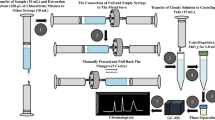Summary
Two men were exposed to toluene diisocyanate (TDI) atmospheres at three different air concentrations (ca. 25, 50 and 70μg/m3) . The TDI atmospheres were generated by a gas-phase permeation method, and the exposures were performed in an 8-m3 stainless-steel test chamber. The effective exposure period was 4h. The isomeric composition of the air in the test chamber was 30% 2,4-TDI and 70% 2,6-TDI. The concentration of TDI in air of the test chamber was determined by an HPLC method using the 9-(N-methyl-amino-methyl)-anthracene reagent and by a continuous-monitoring filter-tape instrument. Following the hydrolysis of plasma and urine, the related amines, 2,4-toluenediamine (2,4-TDA) and 2,6-toluenediamine (2,6-TDA), were determined as pentafluoropropionic anhydride (PFPA) derivatives by capillary gas chromatography using selected ion monitoring (SIM) in the electron-impact mode. In plasma, 2,4- and 2,6-TDA showed a rapid-phase elimination half-time of ca. 2–5 h, and that for the slow phase was > 6 days. A connection was observed between concentrations of 2,4- and 2,6-TDI in air and the levels of 2,4- and 2,6-TDA in plasma. The cumulated amount of 2,4-TDA excreted in the urine over 24 h was ca. 15%–19% of the estimated inhaled dose of 2,4-TDI, and that of 2,6-TDA was ca. 17%–23% of the inhaled dose of 2,6-TDI. A connection was found between the cumulated (24-h) urinary excretion of 2,4- and 2,6-TDA and the air concentration of 2,4- and 2,6-TDI in the test chamber. A connection was also observed between the rate of urinary excretion of 2,4- and 2,6-TDA over the last 2h of exposure and the air concentration of 2,4- and 2,6-TDI in the test chamber. Biological monitoring of exposure to monomeric 2,4- and 2,6-TDI by the analysis of 2,4- and 2,6-TDA in biological media is feasible. A method based on 24-h urine sampling and determination levels of 2,4- and 2,6-TDA in hydrolysed urine is recommended. However, exposure to TDI is often associated with aerosols containing polymeric TDI, and we do not know whether analysis of TDA in urine can also be used as a marker of exposure to TDI prepolymers.
Similar content being viewed by others
References
American Conference of Governmental Industrial Hygienists (ACGIH) (1989) Threshold limit values and biological exposure indices for 1989–1990. ACGHI, Cincinatti, Ohio, pp 57–69
Brorson T, Skarping G, Renman L, Sangö C (1989) Test atmospherses of diisocyanates with special reference to controlled exposure of humans. Int Arch Occup Environ Health 61:495–501
Brorson T, Skarping G, Nielsen J (1990) Biological monitoring of diisocyanates and related amines: II. Test chamber exposure of humans to 1,6-hexamethylene diisocyanate (HDI). Int Arch Occup Environ Health 62:385–389
Brown WE, Green AH, Cedel TE, Cairns J (1987) Biochemistry of protein-isocyanate interactions: a comparison of the effects of aryl vs alkyl isocyanates. Environ Health Persp 72:5–11
Gilbert DS (1988) Fate of TDI and MDI in air, soil, and water. J Cell Plast 24:178–192
Grantham PH, Mohan L, Benjamin T, Roller PP, Miller JR, Weisburger EK (1980) Comparison of the metabolism of 2,4toluenediamine in rats and mice. J Environ Pathol Toxicol 3:149–166
Hanson A, Melander A, Wåhlin-Boll E (1981) Acetylator phenotyping: a comparison of the isoniazid and dapsone tests. Eur J Clin Pharmacol 20:233–234
Hagmar L, Nielsen J, Skerfving S (1987) Clinical features and epidemiology of occupational obstructive respiratory disease caused by small molecular weight organic chemicals. Monogr Allergy 21:42–58
Hill BL, Karol MH, Brown WE (1986) The fate of inhaled [14C]-toluene diisocyanate in sensitized guinea pigs. Toxicologist 6:15
Kennedy AL, Stock MF, Alarie Y, Brown WE (1989) Uptake and distribution of 14C during and following inhalation exposure to radioactive toluene diisocyanate. Toxicol Appl Pharmacol 100:280–292
Lowry LK (1986) Biological exposure index as a complement to the TLV. J Occup Med 28:578–582
Ozawa H (1967) Bridging reagent for protein: I. The reaction of diisocyanates with lysine and enzyme proteins. J Biochem 62:419–423
Rosenberg C, Savolainen H (1985) Detection of urinary amine metabolites in toluene diisocyanate-exposed rats. J Chromatogr 323:429–433
Rosenberg C, Savolainen H (1986) Determination of occupational exposure to toluene diisocyanate by biological monitoring. J Chromatogr 367:385–392
Sandström JF, Skarping G, Dalene M (1989) Chromatographic determination of amines in biological fluids with special reference to the biological monitoring of isocyanates and amines: II. Determination of 2,4- and 2,6-toluenediamine in human urine using capillary gas chromatography and selected ion monitoring with special reference to the biological monitoring of exposure to toluene diisocyanates. J Chromatogr 479:135–143
Sangö C, Zimerson E (1980) A new reagent for determination of isocyanates in working atmospheres by HPLC using UV or fluorescence detection. J Liq Chromatogr 3:971–990
Skarping G, Brorson T, Sangö C (1991) Biological monitoring of diisocyanates and related amines: III. Test chamber exposure of humans to toluene diisocyanate (TDI). Int Arch Occup Environ Health 63:83–88
Ted Tse CS, Pesce AJ (1979) Chemical characterisation of isocyanate-protein conjugates. Toxicol Appl Pharmacol 51:39–46
Unger PD, Salemo AJ, Ness WC, Friedman MA (1980) Tissue distribution and excretion of 2,4-[14C]-toluenediamine in the mouse. J Toxicol Environ Health 6:107–114
Wegman DH, Musk W, Main D, Pagnetto CD (1982) Accelerated loss of FEV1 in polyurethane production workers. A four-year prospective study. Am J Ind Med 3:209–215
Welinder H, Nielsen J, Bensryd I, Skerfving S (1988) IgG antibodies against polyisocyanates in car painters. Clin Allergy 18:85–93
World Health Organisation (1987a) Environmental Health Criteria 75, diamino toluenes. World Health Organisation, Geneva
World Health Organisation (1987b) Environmental Health Criteria 75, toluene diisocyanates. World Health Organisation, Geneva
Author information
Authors and Affiliations
Rights and permissions
About this article
Cite this article
Brorson, T., Skarping, G. & Sangö, C. Biological monitoring of isocyanates and related amines. Int. Arch Occup Environ Heath 63, 253–259 (1991). https://doi.org/10.1007/BF00386374
Received:
Accepted:
Issue Date:
DOI: https://doi.org/10.1007/BF00386374




